- Joined
- Oct 9, 2007
- Messages
- 47,239 (7.55/day)
- Location
- Hyderabad, India
| System Name | RBMK-1000 |
|---|---|
| Processor | AMD Ryzen 7 5700G |
| Motherboard | ASUS ROG Strix B450-E Gaming |
| Cooling | DeepCool Gammax L240 V2 |
| Memory | 2x 8GB G.Skill Sniper X |
| Video Card(s) | Palit GeForce RTX 2080 SUPER GameRock |
| Storage | Western Digital Black NVMe 512GB |
| Display(s) | BenQ 1440p 60 Hz 27-inch |
| Case | Corsair Carbide 100R |
| Audio Device(s) | ASUS SupremeFX S1220A |
| Power Supply | Cooler Master MWE Gold 650W |
| Mouse | ASUS ROG Strix Impact |
| Keyboard | Gamdias Hermes E2 |
| Software | Windows 11 Pro |
Intel in its 2021 Architecture Day presentation put out fine technical details of its Xe HPC Ponte Vecchio accelerator, including some [very] preliminary performance claims for its current A0-silicon-based prototype. The prototype operates at 1.37 GHz, but achieves out at least 45 TFLOPs of FP32 throughput. We calculated the clock speed based on simple math. Intel obtained the 45 TFLOPs number on a machine running a single Ponte Vecchio OAM (single MCM with two stacks), and a Xeon "Sapphire Rapids" CPU. 45 TFLOPs sees the processor already beat the advertised 19.5 TFLOPs of the NVIDIA "Ampere" A100 Tensor Core 40 GB processor. AMD isn't faring any better, with its production Instinct MI100 processor only offering 23.1 TFLOPs FP32.
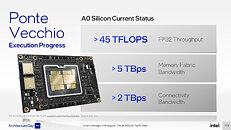
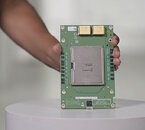
"A0 silicon" is the first batch of chips that come back from the foundry after the tapeout. It's a prototype that is likely circulated within Intel internally, and to a very exclusive group of ISVs and industry partners, under very strict NDAs. It is common practice to ship prototypes with significantly lower clock speeds than what the silicon is capable of, at least to the ISVs, so they can test for functionality and begin developing software for the silicon.
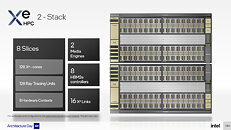

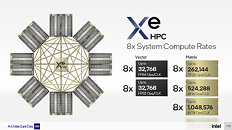

Our math for the clock speed is as follows. Intel, in the presentation mentions that each package (OAM) puts out a throughput of 32,768 FP32 ops per clock cycle. It also says that a 2-stack (one package) amounts to 128 Xe-cores, and that each Xe HPC core Vector Engine offers 256 FP32 ops per clock cycle. These add up to 32,768 FP32 ops/clock for one package (a 2-stack). From here, we calculate that 45,000 GFLOPs (measured in clpeak by the way), divided by 32,768 FP32 ops/clock, amounts to 1373 MHz clock speed. A production stepping will likely have higher clock speeds, and throughput scales linearly, but even 1.37 GHz seems like a number Intel could finalize on, given the sheer size and "weight" (power draw) of the silicon (rumored to be 600 W for A0). All this power comes with great thermal costs, with Intel requiring liquid cooling for the OAMs. If these numbers can make it into the final product, then Intel has very well broken through into the HPC space in a big way.
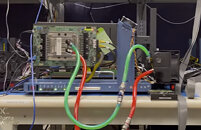

View at TechPowerUp Main Site


"A0 silicon" is the first batch of chips that come back from the foundry after the tapeout. It's a prototype that is likely circulated within Intel internally, and to a very exclusive group of ISVs and industry partners, under very strict NDAs. It is common practice to ship prototypes with significantly lower clock speeds than what the silicon is capable of, at least to the ISVs, so they can test for functionality and begin developing software for the silicon.




Our math for the clock speed is as follows. Intel, in the presentation mentions that each package (OAM) puts out a throughput of 32,768 FP32 ops per clock cycle. It also says that a 2-stack (one package) amounts to 128 Xe-cores, and that each Xe HPC core Vector Engine offers 256 FP32 ops per clock cycle. These add up to 32,768 FP32 ops/clock for one package (a 2-stack). From here, we calculate that 45,000 GFLOPs (measured in clpeak by the way), divided by 32,768 FP32 ops/clock, amounts to 1373 MHz clock speed. A production stepping will likely have higher clock speeds, and throughput scales linearly, but even 1.37 GHz seems like a number Intel could finalize on, given the sheer size and "weight" (power draw) of the silicon (rumored to be 600 W for A0). All this power comes with great thermal costs, with Intel requiring liquid cooling for the OAMs. If these numbers can make it into the final product, then Intel has very well broken through into the HPC space in a big way.


View at TechPowerUp Main Site





 Soo... Can it run Crysis?
Soo... Can it run Crysis?  I think people use the term "crossbar" as shorthand for a "switch that has no restriction on bandwidth" (which a nonblocking CLOS network qualifies), and not necessarily a "physical crossbar" (which takes up O(n^2 space), while CLOS network is O(n*log(n)) space)
I think people use the term "crossbar" as shorthand for a "switch that has no restriction on bandwidth" (which a nonblocking CLOS network qualifies), and not necessarily a "physical crossbar" (which takes up O(n^2 space), while CLOS network is O(n*log(n)) space)